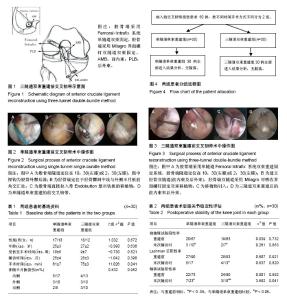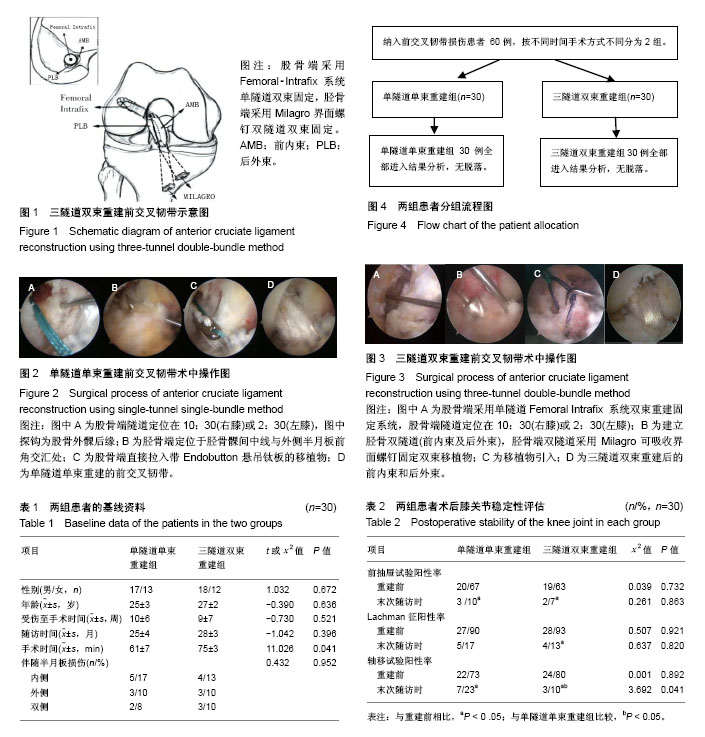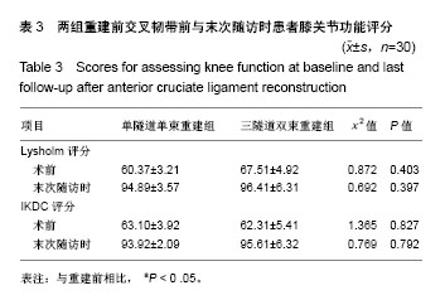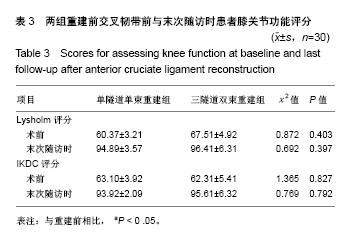| [1] Gianotti SM, Marshall SW, Hume PA, et al., Incidence of anterior cruciate ligament injury and other knee ligament injuries: a national population-based study. J Sci Med Sport.2009; 12(6): 622-627.[2] Aichroth PM, Patel DV, Zorrilla P. The natural history and treatment of rupture of the anterior cruciate ligament in children and adolescents. A prospective review. J Bone Joint Surg Br. 2002;84(1):38-41.[3] Panni AS, Milano G, Tartarone M, et al. Clinical and radiographic results of ACL reconstruction: a 5- to 7-year follow-up study of outside-in versus inside-out reconstruction techniques. Knee Surg Sports Traumatol Arthrosc. 2001;9(2):77-85.[4] Sonnery-Cottet B, Lavoie F, Ogassawara R, et al. Selective anteromedial bundle reconstruction in partial ACL tears: a series of 36 patients with mean 24 months follow-up. Knee Surg Sports Traumatol Arthrosc. 2010;18(1):47-51.[5] Colombet PD. Navigated intra-articular ACL reconstruction with additional extra-articular tenodesis using the same hamstring graft. Knee Surg Sports Traumatol Arthrosc. 2011;19(3):384-389.[6] Gadikota HR, Wu JL, Seon JK, et al. Single-tunnel double-bundle anterior cruciate ligament reconstruction with anatomical placement of hamstring tendon graft: can it restore normal knee joint kinematics? Am J Sports Med. 2010;38(4):713-20.[7] Iriuchishima T, Tajima G, Shirakura K, et al. In vitro and in vivo AM and PL tunnel positioning in anatomical double bundle anterior cruciate ligament reconstruction. Arch Orthop Trauma Surg. 2011; 131(8):1085-1090.[8] Colombet P, Robinson J, Christel P, et al. Using navigation to measure rotation kinematics during ACL reconstruction. Clin Orthop Relat Res. 2007; 454:59-65.[9] Beaulieu ML, Wojtys EM, Ashton-Miller JA. Ashton-Miller, Risk of anterior cruciate ligament fatigue failure is increased by limited internal femoral rotation during in vitro repeated pivot landings. Am J Sports Med. 2015; 43(9):2233-2241.[10] Komzák M, Hart R, Feranec M, et al. In vivo knee rotational stability 2 years after double-bundle and anatomic single-bundle ACL reconstruction. Eur J Trauma Emerg Surg. 2018;44(1): 105-111.[11] Verhelst L, Van Der Bracht H, Oosterlinck D, et al. ACL repair with a single or double tunnel: a comparative laboratory study of knee stability using computer navigation. Acta Orthop Belg.2012;78(6): 771-778.[12] Georgoulis AD, Ristanis S, Chouliaras V, et al. Tibial rotation is not restored after ACL reconstruction with a hamstring graft. Clin Orthop Relat Res. 2007;454:89-94.[13] Yagi M, Kuroda R, Nagamune K, et al. Double-bundle ACL reconstruction can improve rotational stability. Clin Orthop Relat Res. 2007; 454:100-107.[14] Hussein M, van Eck CF, Cretnik A, et al. Individualized anterior cruciate ligament surgery: a prospective study comparing anatomic single- and double-bundle reconstruction. Am J Sports Med.2012; 40(8):1781-1788.[15] Fu FH, Karlsson J.A long journey to be anatomic. Knee Surg Sports Traumatol Arthrosc. 2010; 18(9): 1151-1153.[16] Järvelä S, Kiekara T, Suomalainen P, et al. Double-bundle versus single-bundle anterior cruciate ligament reconstruction: a prospective randomized study with 10-year results. Am J Sports Med. 2017;45(11):2578-2585.[17] El-Sherief FAH, Aldahshan WA, Wahd YE, et al. Double-bundle anterior cruciate ligament reconstruction is better than single-bundle reconstruction in terms of objective assessment but not in terms of subjective score. Knee Surg Sports Traumatol Arthrosc. 2017. doi: 10.1007/s00167-017-4804-3.[18] Ahn JH, Kang HW, Choi KJ. Outcomes after double-bundle anterior cruciate ligament reconstruction. Arthroscopy. 2018; 34(1):220-230. [19] Ahn JH, Lee SH. Anterior cruciate ligament double-bundle reconstruction with hamstring tendon autografts. Arthroscopy. 2007;23(1): 109.[20] Zelle BA, Vidal AF, Brucker PU, et al. Double-bundle reconstruction of the anterior cruciate ligament: anatomic and biomechanical rationale. J Am Acad Orthop Surg. 2007;15(2): 87-96.[21] Beyaz S, Güler ÜÖ, Demir ?, et al. Tunnel widening after single- versus double-bundle anterior cruciate ligament reconstruction: a randomized 8-year follow-up study. Arch Orthop Trauma Surg. 2017;137(11): 1547-1555.[22] van Eck CF, Kopf S, Irrgang JJ, et al. Single-bundle versus double-bundle reconstruction for anterior cruciate ligament rupture: a meta-analysis--does anatomy matter? Arthroscopy. 2012;28(3): 405-424.[23] Zantop T, Wellmann M, Fu FH, et al. Tunnel positioning of anteromedial and posterolateral bundles in anatomic anterior cruciate ligament reconstruction: anatomic and radiographic findings. Am J Sports Med. 2008;36(1): 65-72.[24] Irrgang JJ, Tashman S, Moore C, et al. Challenge accepted: description of an ongoing NIH-funded randomized clinical trial to compare anatomic single-bundle versus anatomic double-bundle ACL reconstruction. Arthroscopy.2012;28(6):745-747.[25] Nakayama H, Kambara S, Iseki T, et al. Double-bundle anterior cruciate ligament reconstruction with and without remnant preservation - Comparison of early postoperative outcomes and complications. Knee. 2017;24(5):1039-1046.[26] Fujita N, Kuroda R, Matsumoto T, et al. Comparison of the clinical outcome of double-bundle, anteromedial single-bundle, and posterolateral single-bundle anterior cruciate ligament reconstruction using hamstring tendon graft with minimum 2-year follow-up. Arthroscopy. 2011;27(7):906-913.[27] Patel VV, Hall K, Ries M, et al. A three-dimensional MRI analysis of knee kinematics. J Orthop Res. 2004; 22(2):283-292.[28] DeFrate LE, Sun H, Gill TJ, et al. In vivo tibiofemoral contact analysis using 3D MRI-based knee models. J Biomech.2004; 37(10):1499-1504.[29] Li G, Defrate LE, Rubash HE, et al. In vivo kinematics of the ACL during weight-bearing knee flexion. J Orthop Res. 2005;23(2): 340-344. |



